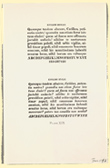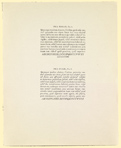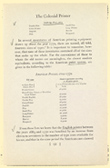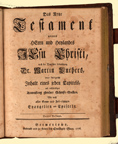| |
N.B. All text in black excerpted from Lawrence C. Wroth's The Colonial Printer. Curatorial remarks are in red.
TYPE and Type FOUNDING
The printer of colonial America reckoned as one of the recurrent difficulties of his trade the necessity of keeping replenished the three or four fonts of type that were essential to the conduct of his business. During the early years of his period,…even the English printer was not able to secure easily new fonts of letters or even the necessary "sorts," and later, when the Caslon, the Wilson, the Martin, and other foundries were turning out excellent type in quantity, the cost of the fonts and of their transportation was a serious item in the calculations of the distant American craftsman. The Colonial Printer, p. 90
|
|
| |
     |
|
|
5) The American museum: or, repository of ancient and modern fugitive pieces, etc. prose and poetical. Philadelphia: Mathew Carey, 1787.
In comparison with this table, it is interesting to turn to an article by Francis Hopkinson in Matthew Carey's American Museum for May, 1787, dated July 31, 1786, in which it is suggested that in literary composition the several emotions of joy, earnestness, passion, and agitation be expressed by various sizes and faces of type. In setting this ingenious essay Carey made use of fourteen type sizes, of which twelve were in roman, one in italic, and one in black letter. He did not mention long primer and pica, but as he certainly possessed these, we can think of him as having in his cases at least sixteen available sizes. Of sizes not in use in the earlier list given above, we find him using minion, nonpareil, and pearl, small types of great usefulness in modern times for notes and for matter to be set in compressed style. The Colonial Printer, p. 93 |
|
| |
|
|
|
|
6) Increase Mather. Wo [sic] to drunkards. Two sermons testifying against the sin of drunkenness, wherein the wofulness [sic]of that evil, and the misery of all that are addicted to it. Cambridge: Marmaduke Johnson, sold by Edmund Ranger, 1673.
|
|
 |
7) Urian Oakes. New-England pleaded with, and pressed to consider the things which concern her peace. Cambridge: Samuel Green, 1673.
Isaiah Thomas says of the Cambridge press that its cases included a small amount of Greek and Hebrew letter. Hebrew letter, indeed, was used in the Bay Psalm Book of 1640 (Item 31), and at least one word printed in Greek letter is found in a marginal note in Increase Mather's Wo to Drunkards, printed by Marmaduke Johnson in Cambridge, 1673. In this same year the Cambridge press of Samuel Green also made use of Greek and Hebrew letters in printing Urian Oakes's New-England Pleaded With. Such variety was rare in the colonial printing houses. The Colonial Printer, p. 94 |
|
| |
|
|
 |
8) Harvard College. Pietas et gratulatio collegii Cantabrigiensis apud Novanglos. Boston: J. Green & J. Russell, 1762.
In 1728, William Parks transliterated the Greek words on the title-page of Holdsworth's Muscipula, and as late as July 2, 1764, Jonas Green transliterated certain Greek words quoted in the Maryland Gazette, and in a note said: "Greek. But we have no Greek types." Three years before this time, though, J. Green and J. Russell, printers of Boston, were able to set a poem of several stanzas in Greek type in their Pietas et Gratulatio Collegii Cantabrigiensis, an excellently printed work showing, I believe, the first extensive use of Greek letter by a colonial press. It should be said that the Greek types employed in the Pietas, a poem addressed by Harvard men of letters to George III on his accession, were not the property of Messrs. Green and Russell, the printers, but of the College, to which these and a font of Hebrew characters had been presented in 1726 by Thomas Hollis, of London, a persistent patron of the institution at Cambridge. This was the first and only use of the Greek font, which was destroyed when the college library was burned in 1764. The Colonial Printer, The Colonial Printer, pp. 94-95 |
|
| |
|
|
|
9) Church of England. The order for morning and evening prayer, and administration of the sacraments, and some other offices of the church. New York: William Weyman and Hugh Gaine, 1769.
The making by printers of single letters, or the casting of "sorts," to meet the emergencies of the job in hand is not to be regarded here as an aspect of that type-founding industry of which we are seeking the origins. Franklin relates that while putting Keimer's equipment in order at Philadelphia in 1727, or soon thereafter, he made matrices of lead, using old types as punches, and from these, in a mould of his own contrivance, cast successfully in lead such letters and sorts as were missing from the font. The elder Christopher Sower is said to have met the exigencies of his shop in a similar fashion. Not all printers were equally resourceful. As one of his reasons for failing to complete the Mohawk Book of Common Prayer in 1769, Weyman offered somewhat peevishly the excuse that his establishment did not have "the Command of a Letter Makers founding-House to suit ourselves in ye particular Sorts required such as g's, k's, y's, &c, &c, …" When Hugh Gaine took over the printing of this book, however, it went forward without delay, but we do not know whether the needed sorts were cast in his shop or imported from London. The Colonial Printer, pp. 97-98 |
|
| |
 |
|
 |
The FIRST WORK with American TYPES: Jacob BAY and Justus FOX
10) Biblia, das ist. Germantown: Christoph Saur, 1776.
In April, 1772, Sower employed Jacob Bay, a newly arrived Swiss silk weaver, to assist Justus Fox in the work of casting type for the great Bible. After two years' service, Bay left Fox and set up for himself as a type founder near by in Germantown. It is recorded by William McCulloch that hereupon Bay "cast a number of fonts, cutting all the punches, and making all the apparatus pertaining thereto, himself, for Roman Bourgeois, Long Primer, etc." Fox remained in Sower's employ where, in addition to his routine of casting fraktur for the great Bible of 1776, he cut and cast a certain amount of roman letter on his own initiative. The Colonial Printer, pp. 103-104
|
|
| |
|
|
|
11) Encyclopaedia; or, a dictionary of arts, sciences, and miscellaneous literature. Philadelphia: Thomas Dobson, 1798.
The coming of the Baines, mature and experienced craftsmen, marked the beginning of a new period in American type founding. The Baines must have worked with intense industry during the years before the death of the elder in 1790, for they soon established themselves as the leading American type founders. When Thomas Dobson, the Philadelphia printer, began in 1790 the serial publication of the American issue of the third Encyclopaedia Britannica, a monumental undertaking of eighteen volumes that took seven years to finish, it was to the Messrs. Baine that he turned for his type, and from them that he secured the excellent letter in which the great book was printed. The Colonial Printer, pp. 109-110
Plates XVIII and XIX
The Type of Binny & Ronaldson shows itself a finished product in their specimen book of 1812, the first to be printed in the United States. The English Roman was a modern face partaking of the worst features of the period, but the Pica Roman, No. 1, showed the maintenance of tradition in a transitional face popular today with many printers under the name "Oxford." The Colonial Printer, p. xi |
|
| |
|
|
| |
Punches, matricies and "sorts"
from Daniel Berkley Updike's Merrymount Press. Updike printed the first edition of The Colonial Printer. (On loan from the D. B. Updike collection, Special Collections, Providence Public Library) |
|
| |
 |
|
|
Printing INK
In the year 1747, Benjamin Franklin received a letter from Jonas Green in which the Annapolis printer wrote that he required "some varnish (a bottle by the post) and 4 or 5 Pound of Lampblack." In these words is found an order for the ingredients of printing ink; that is for varnish, or linseed oil boiled with rosin, and for lampblack, the impalpable soot derived from the smoke of carbonaceous substances. It was not a particularly small order, either, for lampblack is a bulky stuff, and in this letter to his friend, supporter, and agent, Green was asking for about a third of a barrel of the pigment needed in mixing the ink to be used in his shop. The Colonial Printer, p. 115
12) Some letters and an abstract of letters from Pennsylvania, containing the state and improvement of that province. London: Andrew Sowe [i.e. Sowle], 1691.
Doubtless here and elsewhere, the expressing of the useful linseed oil was undertaken as a matter of course as soon as flaxseed began to be obtainable in quantity. Certainly oil mills were erected at an early period. In Some Letters and an Abstract of Letters from Pennsylvania, London, 1691, C. Pickering wrote home from the province, "An Oil-Mill is erecting to make Coal and Rape-Seed-Oyle, &c." The Colonial Printer, p. 117 |
|
| |
At a mere seven pages, Wroth’s chapter on Printing Ink is the shortest of the twelve chapters in the book. Here are the manuscript and galley proofs of the first edition, showing Wroth’s additions. |
|
| |
   |
|
| |
 |
|
| |
The PAPER of the COLONIES
It must be understood that the paper made in colonial America, especially in the early days, was not the finest in quality. The word "handmade" has a connotation in these days that dazzles the intelligence even of persons ordinarily unimpressed by shibboleths. The American paper of the seventeenth and early eighteenth centuries, handmade, of course, from rags, was an honest paper, tough and durable in general, but as variable in quality as one would expect from indifferent materials handled by provincial workmen in rude manufactories. The Colonial Printer, pp. 122-123 |
|
| |
|
|
|
13) Bernard Romans. Philadelphia, August 5, 1773: Proposals for printing by subscription, three very elegant and large maps of the navigation, to, and in, the new ceded countries. Philadelphia: William and Thomas Bradford, 1773.
Whatever may have been the ultimate influence of Gaine's paper mill on the importation of paper, it is certain that some years elapsed before the practice of bringing in paper from Pennsylvania was discontinued by the New York printers. When, in 1774, Rivington was printing Bernard Romans's great charts of the Florida waters on thirteen sheets, each measuring 22 x 28 inches, it was announced that the paper for this extraordinary production had been made to order in Pennsylvania. The Colonial Printer, p. 131 |
|
| |
|
|
|
14) Biblia, das ist. Germantown: Christoph Saur, 1743.
There is no doubt that during a large part of the colonial period the Pennsylvania mills supplied the middle colonies with their ordinary printing paper, and indeed with the paper for some very important books as well. Sower's great German Bible, issued in 1743, was printed in part, it is often said, on paper made in the mill conducted by the Seventh Day Baptist brotherhood at Ephrata, established probably about 1740; and the Mennonite Martyr Book of 1748 (Item 30), containing 756 leaves folio, was printed in the Ephrata monastery on paper made in the mill of the Bruderschaft. The Colonial Printer, pp. 132-133 |
|
| |
|
|
|
16) The Providence gazette and country journal. Providence: William Goddard, 1762.
The continuance of [the] mill [owned by Jonathan Olney, John Waterman, and Jonathan Ballau] is attested by the appearance of advertisements for rags in the Providence Gazette for many years, and by the fact that in 1780 there was going on in Providence a rivalry in rag buying between the "old Paper-Mill," controlled by Christopher Olney, and the "new Paper-Mill, " built, probably, in the summer of 1780, by Samuel Thurber in the north end of the town. The date of the beginning of Rhode Island paper making is usually given as that of the establishment of the Thurber mill, but recent investigations indicate that the date should be set sixteen years earlier with the establishment in 1764 of the mill by Jonathan Olney, John Waterman, and Jonathan Ballau for which William Goddard, we have supposed, wrote [a] vigorous prospectus. The Colonial Printer, pp. 140-141 |
|
| |
|
|
|
17) Select essays: Containing: The manner of raising and dressing flax, and hemp…And an enquiry, concerning the materials that may be used in making paper. Philadelphia: Robert Bell, 1777.
The interest of Robert Bell did not cease with the proposal of plans for the collection of rags. In 1777 appeared in Philadelphia, bearing his imprint, a work known as Select Essays . . . Collected from the Dictionary of Arts and Sciences and from various modern Authors. Among the several treatises on the raising of flax and hemp, the making of linen, the management of sheep and cows, and the culture of vegetables, is found an essay by the French physician Jean Etienne Guettard, entitled "An Enquiry Concerning the Materials that may be used in making Paper." Reprinted from a similar London collection of 1754, this treatise by Guettard stands as the first writing on the subject of paper making to come from the American press. The Colonial Printer, p. 150 |
|
| |
|
|
|
18) American Philosophical Society. Transactions, of the American philosophical society, held at Philadelphia, for promoting useful knowledge. Philadelphia, 1771-1806.
The omniscient Franklin was next to be heard from. In 1793, in the Transactions of the American Philosophical Society, was published a communication by Franklin, read to the Society in 1788, with the title, "Description of the process to be observed in making large sheets of paper in the Chinese manner, with one smooth surface." This discussion of a process in paper-making technique by the aged Franklin seems to have been the only strictly American contribution to the bibliography of paper making that appeared in the eighteenth century. The Colonial Printer, p. 150 |
|
| |
|
|
|
19) Charlotte Smith. Elegiac sonnets, and other poems. Worcester: Isaiah Thomas, 1795.
Wove paper was regularly in use in England soon after its invention, and in 1777 Franklin exhibited specimens of it in France. A few years later, in 1782, its successful manufacture began in that country too, where, as papier velin, it quickly became popular with the printers of fine books. Its manufacture in America, always conservative, seems to have been deferred almost to the close of the century. I have not seen an earlier reference to a native-made wove paper than the sentence which occurs in the note appended to the Elegiac Sonnets and other Poems of Charlotte Smith, printed by Isaiah Thomas in Worcester, in 1795. Of the excellent wove paper used in that book, Thomas wrote : "The making of the particular kind of paper on which these sonnets are printed, is a new business in America; and but lately introduced into Great Britain; it is the first manufactured by the editor." The Colonial Printer, pp. 125-126 |
|
| |
|
|